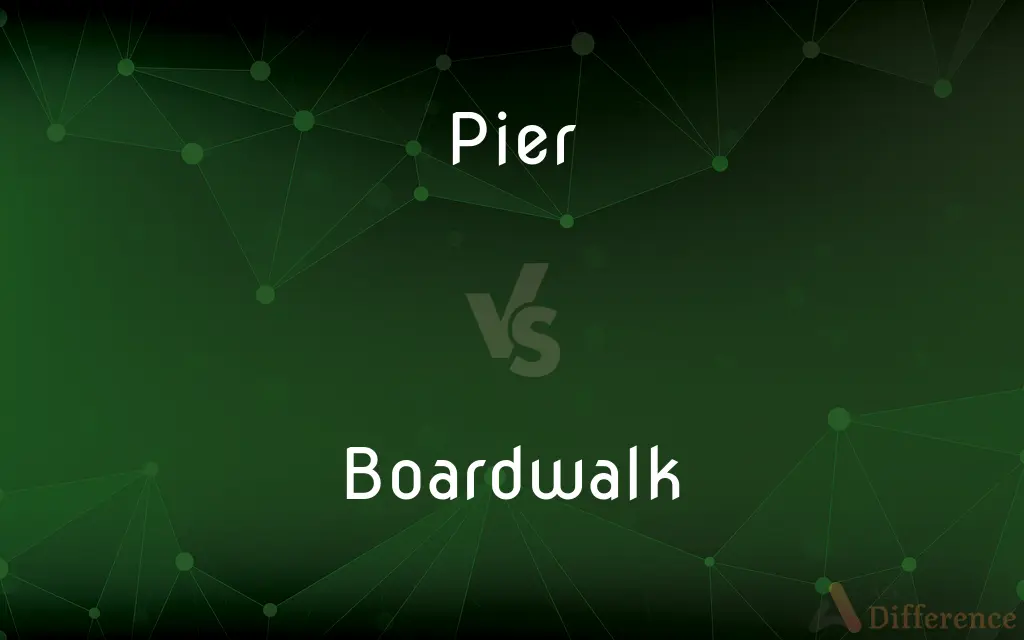Pier vs. Boardwalk — What's the Difference?
By Tayyaba Rehman & Maham Liaqat — Updated on April 4, 2024
A pier is a raised structure over water, supported by pillars, used for docking or leisure, whereas a boardwalk is a pathway or promenade made of wooden planks, often along beaches or waterfronts.

Difference Between Pier and Boardwalk
Table of Contents
ADVERTISEMENT
Key Differences
Piers extend from the land into the water, serving various purposes such as providing docking spaces for boats, fishing platforms, or areas for entertainment and dining. They are characterized by their support structures, which can be piles or columns, that hold them above water. Boardwalks, on the other hand, are constructed primarily for pedestrian use, creating walkable routes along beaches, waterfronts, or through scenic areas. While typically made of wood, modern boardwalks can also utilize composite materials.
The primary function of a pier is to facilitate access to water for boats, fishing, or sightseeing, making it a focal point for marine activities. Conversely, boardwalks are designed to enhance pedestrian access and enjoyment of a waterfront, beach, or other attractions, often featuring shops, restaurants, and leisure facilities along their length.
Piers often project into bodies of water, providing a bridge between land and water activities, and can vary greatly in length, from short structures just beyond the shoreline to lengthy platforms extending far into the water. Boardwalks run parallel to the shoreline or waterfront, offering a protective barrier between fragile ecosystems or private properties and the public, while also providing a recreational space.
Maintenance considerations for piers and boardwalks differ due to their construction and purpose. Piers must withstand marine conditions, including tides, currents, and saltwater corrosion, requiring robust engineering and materials. Boardwalks, while also exposed to the elements, primarily need to maintain their surface integrity for safe pedestrian use, addressing wear from foot traffic and environmental factors.
Both piers and boardwalks serve as cultural and recreational landmarks, but their distinct purposes—marine access and activity versus pedestrian recreation and commerce—reflect their unique roles in coastal and waterfront communities.
ADVERTISEMENT
Comparison Chart
Primary Material
Varied (wood, concrete, steel)
Wood or composite materials
Main Purpose
Access to water, docking, fishing, sightseeing
Pedestrian pathway along beaches or waterfronts
Location
Extends into water
Parallel to shoreline or waterfront
Support Structure
Piles or columns
Built on the ground or slightly elevated
Key Uses
Boating, fishing, dining, entertainment
Walking, shopping, leisure activities
Compare with Definitions
Pier
Used for sightseeing or marine access.
The pier extends into the bay, offering stunning views of the coastline.
Boardwalk
Designed for pedestrian use, often elevated from the beach.
The new boardwalk offers a scenic route along the coast.
Pier
A structure projecting into water for use as a docking or fishing spot.
The old wooden pier is a favorite spot for local fishermen.
Boardwalk
Enhances access to and enjoyment of waterfront areas.
The renovated boardwalk has improved the waterfront’s appeal.
Pier
Built on supports over water, often for recreational activities.
The city’s new pier includes a small amusement park.
Boardwalk
A wooden walkway along a beach or waterfront.
The boardwalk is lined with shops and cafes, attracting tourists year-round.
Pier
Sometimes features restaurants, shops, or entertainment venues.
They enjoyed dinner at a restaurant located at the end of the pier.
Boardwalk
A popular destination for walking and leisure activities.
Families and joggers enjoy the expansive boardwalk by the sea.
Pier
A landing place for boats and ferries.
Tourists board the island ferry at the downtown pier.
Boardwalk
Can feature attractions like amusement parks or arcades.
The boardwalk’s old-fashioned arcade is a hit with visitors.
Pier
A platform built out from the shore into the water and supported by piles; provides access to ships and boats
Boardwalk
A boardwalk (alternatively board walk, boarded path, or promenade) is an elevated footpath, walkway, or causeway built with wooden planks that enables pedestrians to cross wet, fragile, or marshy land. They are also in effect a low type of bridge.
Pier
A pier is a raised structure that rises above a body of water and usually juts out from its shore, typically supported by piles or pillars, and provides above-water access to offshore areas. Frequent pier uses include fishing, boat docking and access for both passengers and cargo, and oceanside recreation.
Boardwalk
A walk made of wooden planks.
Pier
A platform extending from a shore over water and supported by piles or pillars, used to secure, protect, and provide access to ships or boats.
Boardwalk
A promenade, especially of planks, along a beach or waterfront.
Pier
Such a structure used predominantly for entertainment.
Boardwalk
A slightly elevated path for pedestrians over sandy or swampy ground, typically made out of wood; specifically one running alongside a body of water or beach.
Pier
A supporting structure at the junction of connecting spans of a bridge.
Boardwalk
To install a boardwalk over.
Pier
A pillar, generally rectangular in cross section, supporting an arch or roof.
Boardwalk
A walkway made of wooden boards; usually at a seaside. The more elaborate boardwalks at shore resorts are lined with many commercial retail establishments, on the side of the walk opposite the ocean.
Pier
The portion of a wall between windows, doors, or other openings.
Boardwalk
A walkway made of wooden boards; usually at seaside
Pier
A reinforcing structure that projects from a wall; a buttress.
Pier
A raised platform built from the shore out over water, supported on piles; used to secure, or provide access to shipping; a jetty.
Your boat is docked at the pier.
Pier
A similar structure, especially at a seaside resort, used to provide entertainment.
There is a gaming arcade on the pier.
Pier
A structure supporting the junction between two spans of a bridge.
Pier
(architecture) A rectangular pillar, or similar structure, that supports an arch, wall or roof, or the hinges of a gate.
Pier
Any detached mass of masonry, whether insulated or supporting one side of an arch or lintel, as of a bridge; the piece of wall between two openings.
Pier
A projecting wharf or landing place.
Pier
(architecture) a vertical supporting structure (as a portion of wall between two doors or windows)
Pier
A support for two adjacent bridge spans
Common Curiosities
Are piers safe during storms?
Piers are built to withstand normal marine conditions but may be closed during severe weather to ensure public safety.
Are piers only used for leisure activities?
While many piers are designed for leisure, others serve commercial or transportation purposes, such as ferry docks or cargo loading areas.
How do environmental concerns affect the construction of piers and boardwalks?
Both must consider environmental impact, such as disruption to marine ecosystems or beach erosion, and often incorporate sustainable materials and designs.
How does climate change affect piers and boardwalks?
Rising sea levels and increased storm intensity pose challenges, requiring adaptive construction methods to ensure longevity.
Can a pier and a boardwalk be connected?
Yes, a pier can extend from a boardwalk into the water, combining marine and pedestrian recreational activities in one location.
Can boardwalks be found away from water?
Yes, boardwalks can also be built in non-coastal areas for scenic walks through parks or natural reserves.
What makes a pier different from a wharf?
A pier is a single structure extending into the water, while a wharf typically refers to a larger, more complex docking facility along the shoreline.
What’s the economic impact of boardwalks on local communities?
Boardwalks can significantly boost local economies by attracting tourists, supporting local businesses, and increasing property values.
Can boardwalks have vehicular access?
While primarily for pedestrian use, some boardwalks may permit bicycles or maintenance vehicles, but rarely cars.
Can the public participate in the design of new piers or boardwalks?
Public input is often sought in the planning stages to ensure these structures meet community needs and preferences.
How long can a boardwalk be?
Boardwalks vary in length, from short paths to several miles long, providing extensive access along coastlines or waterfronts.
How are piers maintained over time?
Piers require regular inspection and maintenance to address wear from water, weather, and use, including replacing damaged supports or decking.
How do piers and boardwalks contribute to biodiversity?
Properly designed, they can enhance local ecosystems, providing habitat and promoting biodiversity, especially when integrated with environmental conservation efforts.
Are there historical piers and boardwalks?
Many piers and boardwalks hold historical significance, serving as iconic landmarks and preserving the cultural heritage of their locations.
Are there accessibility considerations for piers and boardwalks?
Modern designs include accessibility features such as ramps and handrails to ensure everyone can enjoy these public spaces.
Share Your Discovery

Previous Comparison
Photon vs. Quantum
Next Comparison
Theory vs. ModelAuthor Spotlight
Written by
Tayyaba RehmanTayyaba Rehman is a distinguished writer, currently serving as a primary contributor to askdifference.com. As a researcher in semantics and etymology, Tayyaba's passion for the complexity of languages and their distinctions has found a perfect home on the platform. Tayyaba delves into the intricacies of language, distinguishing between commonly confused words and phrases, thereby providing clarity for readers worldwide.
Co-written by
Maham Liaqat













































